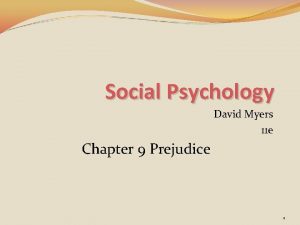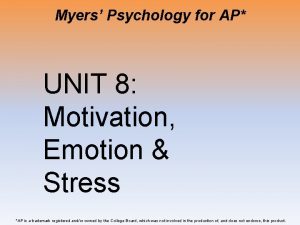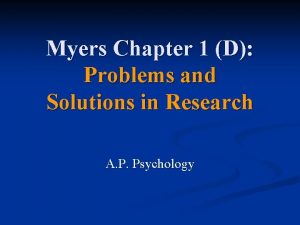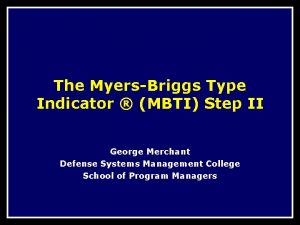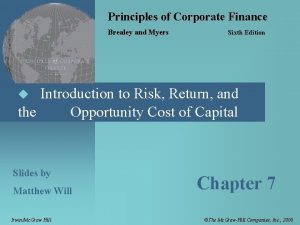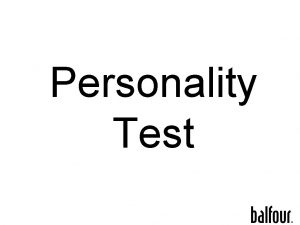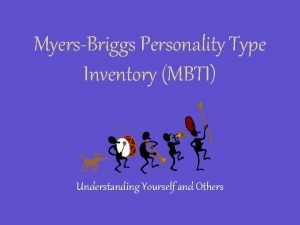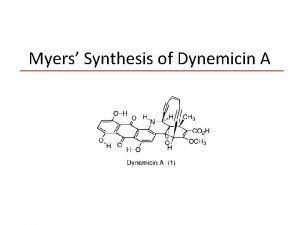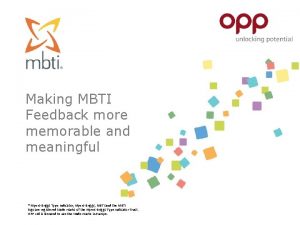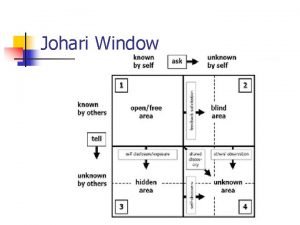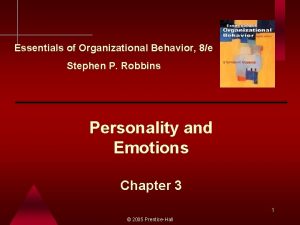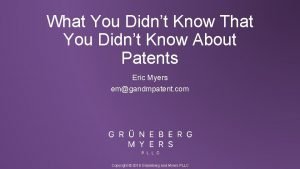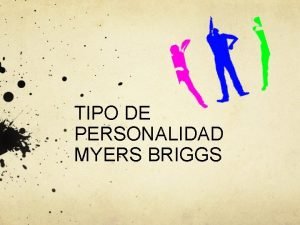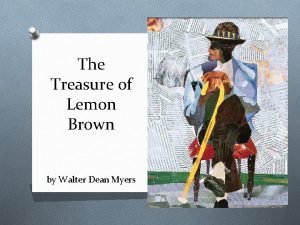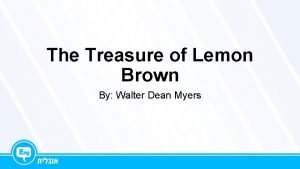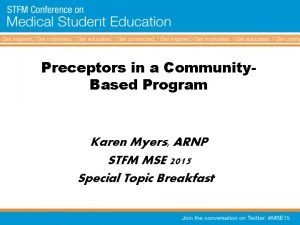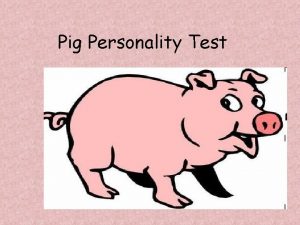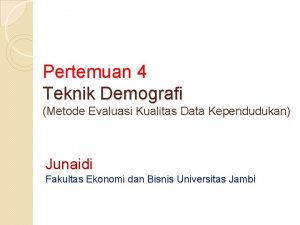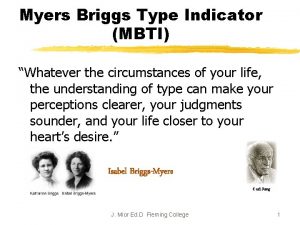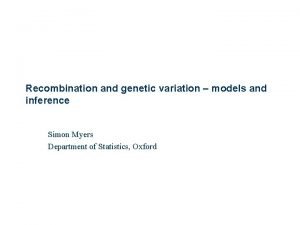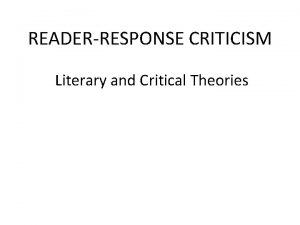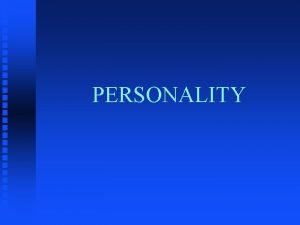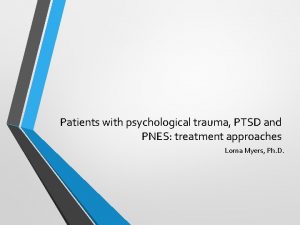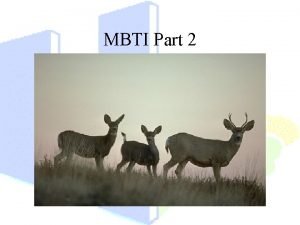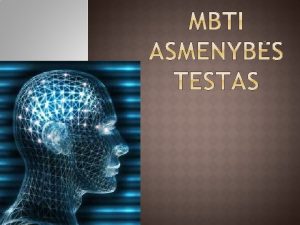Chapter 13 Social Psychology PSYCHOLOGY David G Myers




























































- Slides: 60

Chapter 13 Social Psychology PSYCHOLOGY David G. Myers C. Nathan De. Wall Twelfth Edition

Chapter Overview § Social Thinking § Social Influence § Antisocial Relations § Prosocial Relations

Social Thinking (part 1) § Social psychology § The scientific study of how we think about, influence, and relate to one another § Social psychologists § Use scientific methods to study how people think about, influence, and relate to one another § Study the social influences that explain why the same person will act differently in different situations

Social Thinking (part 2) § Fundamental attribution error § The tendency for observers, when analyzing others’ behavior, to underestimate the impact of the situation and to overestimate the impact of personal disposition § Is most likely to occur when a stranger acts badly § Has real-life and social consequences § Napolitan and colleagues (1979) § Students attributed the behavior of others to personal traits, even when they were told that behavior was part of an experimental situation.

Social Thinking (part 3) § When explaining others’ behavior, especially from an individualist Western cultural perspective: § Fundamental attribution error is committed by underestimating the influence of the situation and overestimating the effects of stable, enduring traits. § Behavior is more readily attributed to the influence of the situation. § Explaining and attributing actions can have important real-life social and economic effects.

An Attribution Question Whether we attribute poverty and homelessness to social circumstances or to personal dispositions affects and reflects our political views.

Attitudes Affect Actions (part 1) § Attitudes are feelings influenced by beliefs, which predispose people to have specific reactions to objects, people, and events. § Peripheral route persuasion occurs when people are influenced by incidental cues, such as a speaker’s attractiveness § Central route persuasion occurs when interested people focus on the arguments and respond with favorable thoughts

Actions Affect Attitudes (part 2) § Actions can modify attitudes § Foot-in-the-door phenomenon: The tendency for people who have first agreed to a small request to comply later with a larger request § Role: A set of expectations (norms) about a social position, defining how those in the position ought to behave § Attitudes follow behavior § Cooperative actions, such as those performed by people on sports teams, feed mutual liking. Such attitudes, in turn, promote positive behavior.

Social Thinking (part 4) § When attitudes do not fit with actions, tensions are often reduced by changing attitudes to match actions (cognitive dissonance theory). § We act to reduce the discomfort (dissonance) we feel when two of our thoughts (cognitions) clash. § Brain regions become active when people experience cognitive dissonance. § Through cognitive dissonance, we often bring attitudes into line with our actions (Festinger).

Social Influence § Social contagion § Chartrand colleagues (1999) § Demonstrated the chameleon effect with college students § Automatic mimicry helps people to empathize and feel what others feel. § The more we mimic, the greater our empathy, and the more people tend to like us. § This is a form of conformity.

Conformity and Obedience § Solomon Asch and others have found that people are most likely to adjust their behavior or thinking to coincide with a group standard in the following circumstances: § They feel incompetent or insecure. § Their group has at least three people. § Everyone else agrees. § They admire the group’s status and attractiveness. § They have not already committed to another response. § They know they are being observed. § Their culture encourages respect for social standards.

Asch’s Conformity Experiments Which of the three comparison lines is equal to the standard line? The photo on the right (from one of the experiments) was taken after five people, who were actually working for Asch, had answered, “Line 3. ” The student in the center shows the severe discomfort that comes from disagreeing with the responses of other group members.

People May Conform for Many Reasons § Normative social influence: Influence resulting from a person’s desire to gain approval or avoid disapproval § Informational social influence: Influence resulting from one’s willingness to accept others’ opinions about reality

Milgram’s Obedience Experiments (part 1) § Stanley Milgram’s experiments § People obeyed orders even when they thought they were harming another person. § Strong social influences can make ordinary people conform to falsehoods or exhibit cruel behavior. § In any society, great evil acts often grow out of people’s compliance with lesser evils.

Milgram’s Obedience Experiments (part 2) § Findings from the Milgram experiments § Obedience was highest when: § The person giving orders was nearby and was perceived as a legitimate authority figure. § The research was supported by a prestigious institution. § The victim was depersonalized or at a distance. § There were no role models for defiance.

Milgram’s Follow-up Obedience Experiment

Group Behavior (part 1) § Social facilitation (Triplett): The presence of others arouses people, improving performance on easy or well-learned tasks but decreasing performance on difficult tasks. § Performance can also be hindered because the most likely, but not necessarily the correct, response occurs. § Home town advantage § Crowding effect

Group Behavior (part 2) § Home team advantage § When others observe us, we perform well-learned tasks more quickly and accurately. § On new and difficult tasks, performance is slower and less accurate.

Home Advantage in Team Sports Sport Years Percentage of home games won Nippon League Baseball 1998– 2009 53. 6 Major League Baseball 1903– 2009 53. 9 National Hockey League 1917– 2009 55. 7 International Rugby 1871– 2009 56. 9 National Football League 1966– 2009 57. 3 International Cricket 1877– 2009 57. 4 National Basketball Association 1946– 2009 60. 5 Women’s National Basketball Association 2003– 2009 61. 7 English Premier League Soccer 1993– 2009 63. 0 NCAA Men’s Basketball 1947– 2009 68. 8 Major League Soccer 2002– 2009 69. 1

Group Behavior (part 3) § Social loafing § Tendency for people in a group to exert less effort when pooling their efforts toward attaining a common goal than when individually accountable § Causes § Acting as part of group and feeling less accountable § Feeling individual contribution does not matter § Taking advantage when there is lack of identification with the group

Group Behavior (part 4) § Deindividuation § A loss of self-awareness and self-restraint that occurs in group situations that foster arousal and anonymity § Thrives in many different settings

Behavior in the Presence of Others: Three Phenomena Phenomenon Social context Psychological effect of others’ presence Social facilitation Individual being observed Increased arousal Amplified dominant behavior, such as doing better what one does well (or doing worse what is difficult) Social loafing Group projects Diminished feelings of responsibility when not individually accountable Decreased effort Deindividuation Group setting that fosters arousal and anonymity Reduced self-awareness Lowered self-restraint Behavioral effect

Deindividuation During England’s 2011 riots and looting, rioters were disinhibited by social arousal and by the anonymity provided by darkness and their hoods and masks. Later, some of those arrested expressed bewilderment over their own behavior.

Group Polarization and Groupthink § Group polarization § Group discussions with like-minded others strengthen members’ prevailing beliefs and attitudes. § Internet communication magnifies this effect, for better or for worse. § Groupthink § People are driven by a desire for harmony within a decision-making group, with this desire overriding realistic appraisal of alternatives. § Individual power § The power of the individual and the power of the situation interact. § A small minority that consistently expresses its views may sway the majority.

Group Polarization § If group members are like-minded, discussion strengthens the prevailing opinions. § Talking over racial issues increased prejudice in a highprejudice group of high school students and decreased it in a lowprejudice group (Myers & Bishop, 1970).

Antisocial Relations (part 1) § Prejudice: An unjustifiable (and usually negative) attitude toward a group and its members. Prejudice generally involves stereotyped beliefs, negative feelings, and a predisposition to discriminatory action. § Stereotype: A generalized (sometimes accurate but often overgeneralized) belief about a group of people. § Discrimination: unjustifiable negative behavior toward a group and its members.

Antisocial Relations (part 2) § Prejudice § “Prejudgment” § An unjustified negative attitude toward some group and its members § Often targets a different cultural, ethnic, or gender group § Components § Beliefs § Emotions § Predispositions to action (to discriminate)

Antisocial Relations (part 3) § Implicit prejudice § Implicit racial associations § Implicit association tests results: Even people who deny racial prejudice may carry negative associations. § Unconscious patronization § Lower expectations, inflated praise, and insufficient criticism for minority student achievement

Antisocial Relations (part 4) § Implicit prejudice § Race-influenced perceptions § Automatic racial bias § Reflexive bodily responses § Unconscious, selective responses when looking at faces

Explicit and Implicit Prejudice § Our prejudice is more often implicit—an unthinking knee-jerk response operating below the radar, leaving us unaware of how our attitudes are influencing our behavior. § Psychologists study implicit prejudice in several ways: § Testing for unconscious group associations § Considering unconscious patronization § Monitoring reflexive bodily responses

Prejudice Over Time

Targets of Prejudice (part 1) § Racial and ethnic prejudice § People with darker skin tones experience greater criticism and accusations of immoral behavior (Alter et al. , 2016). § Our perceptions can reflect implicit bias.

Targets of Prejudice (part 2) § Gender prejudice § Overt gender prejudice has declined sharply, but both implicit and explicit gender prejudice and discrimination persist. § Despite equality between the sexes in intelligence scores, people have tended to perceive their fathers as more intelligent than their mothers (Furnham & Wu, 2008).

Targets of Prejudice (part 3) § LBGT prejudice § In 2016 two dozen countries allowed same-sex marriage, but dozens more had laws criminalizing same-sex relationships. § 39 percent of LBGT persons reported having “been rejected by a friend or family member” because of their sexual orientation or gender identity (Pew, 2013 a). § 58 percent reported being “subject to slurs or jokes” (Pew, 2013 a). § 80 percent of LGBT adolescents reported sexual orientationrelated harassment in the prior year (GLSEN, 2012). § Gays and lesbians are America’s most at-risk group for hate crimes (Sherman, 2016).

Roots of Prejudice (part 1) § Social roots of prejudice § Social inequalities: Often lead to the development of attitudes that justify the status quo § Just-world phenomenon: Good is rewarded and evil is punished § Stereotypes: Rationalize inequalities

Roots of Prejudice (part 2) § Groups: Through social identities, people associate themselves with others. § Evolution prepares people to identify with a group. § Ingroup: “Us”—people with whom we share a common identity § Outgroup: “Them”—those perceived as different or apart from our ingroup § Ingroup bias: The tendency to favor our own group

Roots of Prejudice (part 3) § Scapegoat theory: The theory that prejudice offers an outlet for anger by providing someone to blame § Research evidence (Zimbardo) § Prejudice levels tend to be high among economically frustrated people. § In experiments, a temporary frustration increases prejudice.

Cognitive Shortcuts § Forming categories § Humans categorize people by race: Mixed-race people are identified based on their minority identity. § Similarities are overestimated during categorization, creating “us” and “they. ” § Overestimation also occurs, in the form of the otherrace effect or bias.

Categorizing Mixed-Race People

Vivid Cases Feed Stereotypes

The Biology of Aggression § Biology influences aggression at three levels. § Genetic influences § Evidence from animal studies and twin studies; genetic Y chromosome genetic marker; MAOA gene § Alcohol associated with aggressive responses to frustration § Neural influences § Neural systems facilitate or inhibit aggression when provoked § Aggression more likely to occur with frontal lobe damage § Biochemical influences § Testosterone linked with irritability, assertiveness, impulsiveness, and low tolerance for frustration; alcohol effect

Psychological and Social-Cultural Factors in Aggression § Aversive events § Frustration-aggression principle: Frustration creates anger, which can spark aggression § Other anger triggers § Hot temperatures, physical pain, personal insults, foul odors, cigarette smoke, and crowding, among others § Previous reinforcement for aggressive behavior, observing an aggressive role model, and poor selfcontrol

Temperature and Retaliation

Psychological and Social-Cultural Factors in Aggression § Media portrayals of violence provide social scripts that children learn to follow. § Viewing sexual violence contributes to greater aggression toward women. § Playing violent video games increases aggressive thoughts, emotions, and behaviors.

Psychological and Social-Cultural Influences on Aggression Do violent video games teach social scripts for violence? § Nearly 400 studies of 130, 000 people suggest video games can prime aggressive thoughts, decrease empathy, and increase aggression. § Some researchers dispute this finding and note other factors: depression, family violence, and peer influence.

Biopsychosocial Understanding of Aggression

Prosocial Relations (part 1) • Psychology of attraction • Proximity (mere exposure effect) • Physical attractiveness • Similarity of attitudes and interests

Prosocial Relations (part 2) • Modern matchmaking • Internet-formed friendships and romantic relationships are, on average, slightly more likely to last and be satisfying. • Nearly one-fourth of heterosexual couples and two-thirds of same-sex couples met online. • Speed-dating • People who fear rejection often elicit rejection. • Given more options, people make more superficial choices. • Men wish for future contact with more of their speed dates; women tend to be choosier.

Physical Attractiveness § Physical attractiveness predicts how often people date and how popular they feel. § People’s attractiveness is unrelated to their self-esteem and happiness (Diener et al. , 1995; Major et al. , 1984)/ § Strikingly attractive people are sometimes suspicious that praise for their work may just be a reaction to their looks. Less attractive people are more likely to accept praise as sincere (Berscheid, 1981). § For couples who were friends before lovers—who became romantically involved long after first meeting— looks matter less (Hunt et al. , 2015).

In the Eye of the Beholder

Romantic Love (part 1) § Passionate love § Two-factor theory of emotion § Emotions have two ingredients— physical arousal and cognitive appraisal. § Arousal from any source can enhance an emotion, depending on how we interpret and label the arousal. § Sexual desire + growing attachment = passion of romantic love

Romantic Love (part 2) § Companionate love § Passionate love seldom endures. § Passion-fed hormones (testosterone) give way to oxytocin that supports feelings of trust, calmness, and bonding. § Attraction and sexual desire endure, without the obsession of early-stage marriage. § Equity is important to a satisfying and enduring relationship. § Self-disclosure deepens intimacy.

Altruism (part 1) § Altruism is an unselfish concern for the welfare of others. § People are most likely to help when they notice an incident, interpret it as an emergency, and assume responsibility for helping (Darley et al. ). § Odds for being helped increase if the person appears to deserve help or is a woman. § Similarity to self, being unhurried or in a good mood, feeling guilty, and being focused on others and not preoccupied also raise the likelihood of being helped.

Altruism (part 2) § Bystander effect § Tendency for any given bystander to be less likely to give aid if other bystanders are present § Occurs when there is a diffusion of responsibility

The Norms for Helping Positive social norms encourage generosity and enable group living. § Socialization norm: Social expectation that prescribes how we should behave § Reciprocity norm: Expectation that people will respond favorably to each other by returning benefits for benefit (cost-benefit analysis; utilitarianism; social exchange theory) § Social-responsibility norm: Expectation that people should help those who depend on them

Elements of Conflict (part 1) § Conflict § Perceived incompatibility of actions, goals, or ideas § Social trap § A situation in which the conflicting parties, by each pursuing their self-interest rather than the good of the group, become caught in mutually destructive behavior

Elements of Conflict (part 2) § Mirror-image perceptions § Mutual views often held by conflicting people, as when each side sees itself as ethical and peaceful and views the other side as evil and aggressive

Elements of Conflict (part 3) § Enemy perceptions § People in conflict form negative, distorted images of one another (mirror-image perceptions) § “Us” versus “them” develops § Vicious cycle of hostility emerges at individual or national level § Perceptions can become self-fulfilling prophecies

Promoting Peace (part 1) In some cases, contact and cooperation can be transformational. § Contact § Most effective when contact is free of competition and equal status exists § Across 250, 000 people studied in 38 nations, friendly contact with ethnic minorities, older people, and people with disabilities has usually led to less prejudice § Contact is not always enough

Promoting Peace (part 2) § Cooperation § Cooperative contact, not conflict alone, reduces conflict. § Experiments with teens in 11 countries confirm that cooperative learning can maintain or enhance student achievement. § Communication § When real-life conflicts become intense, a third-party mediator may facilitate much needed. § Mediators can help each party voice its viewpoint and understand the other’s needs and goals; change a win-lose orientation to a win-win one/ § Conciliation § GRIT (Graduated and Reciprocated Initiatives in Tension. Reduction) is an alternative to war or surrender.
 Social psychology david myers
Social psychology david myers David myers psychology 9th edition
David myers psychology 9th edition Psychology eighth edition david g myers
Psychology eighth edition david g myers Reuptake psychology
Reuptake psychology Psychology ninth edition david g myers
Psychology ninth edition david g myers Psychology tenth edition in modules
Psychology tenth edition in modules Unit 8 myers ap psychology
Unit 8 myers ap psychology Tutored human enrichment
Tutored human enrichment Myers' psychology for ap solutions
Myers' psychology for ap solutions Psychology in everyday life myers
Psychology in everyday life myers Myers' psychology for ap
Myers' psychology for ap Social trap psychology definition
Social trap psychology definition Fundamental attribution error ap psychology
Fundamental attribution error ap psychology Social psychology is the scientific study of:
Social psychology is the scientific study of: Social thinking and social influence in psychology
Social thinking and social influence in psychology Social thinking adalah
Social thinking adalah Social thinking social influence social relations
Social thinking social influence social relations Walter dean myers poetry
Walter dean myers poetry Bad boy walter dean myers summary
Bad boy walter dean myers summary Bad boy walter dean myers summary
Bad boy walter dean myers summary Myers-briggs step ii test
Myers-briggs step ii test Binary counting sequence
Binary counting sequence Brealey and myers
Brealey and myers Draw pig personality test
Draw pig personality test Personality test orange blue green gold
Personality test orange blue green gold Andrew g. myers
Andrew g. myers Monster by walter dean myers vocabulary
Monster by walter dean myers vocabulary Monster walter dean myers vocabulary
Monster walter dean myers vocabulary S vs n mbti
S vs n mbti Johari window personality test
Johari window personality test Tony robbins myers briggs
Tony robbins myers briggs Drexel university myers hall
Drexel university myers hall Bridge to terabithia questions
Bridge to terabithia questions 5 voices summary
5 voices summary Gruneberg and myers
Gruneberg and myers Bad boy walter dean myers
Bad boy walter dean myers Personalidad del arquitecto
Personalidad del arquitecto The treasure of lemon brown plot diagram
The treasure of lemon brown plot diagram The treasure of lemon brown by walter dean myers
The treasure of lemon brown by walter dean myers Aarian afshari
Aarian afshari Pig personality profile
Pig personality profile Mbti manager
Mbti manager Stewart myers mit
Stewart myers mit Indeks myers adalah
Indeks myers adalah Mbti l
Mbti l True colors word sort
True colors word sort Bad boy by walter dean myers
Bad boy by walter dean myers Myers–briggs type indicator
Myers–briggs type indicator Isabelle duchesnay
Isabelle duchesnay Myers blended index
Myers blended index Andrew myers cornell
Andrew myers cornell Jacobian myers
Jacobian myers Reader response theory
Reader response theory Mbti population
Mbti population Mmpi vs myers briggs
Mmpi vs myers briggs Ptsd seizures
Ptsd seizures Isabel briggs myers
Isabel briggs myers Mbti istj
Mbti istj Myers briggs testas
Myers briggs testas Brad myers cmu
Brad myers cmu Mbti strengths and weaknesses
Mbti strengths and weaknesses
